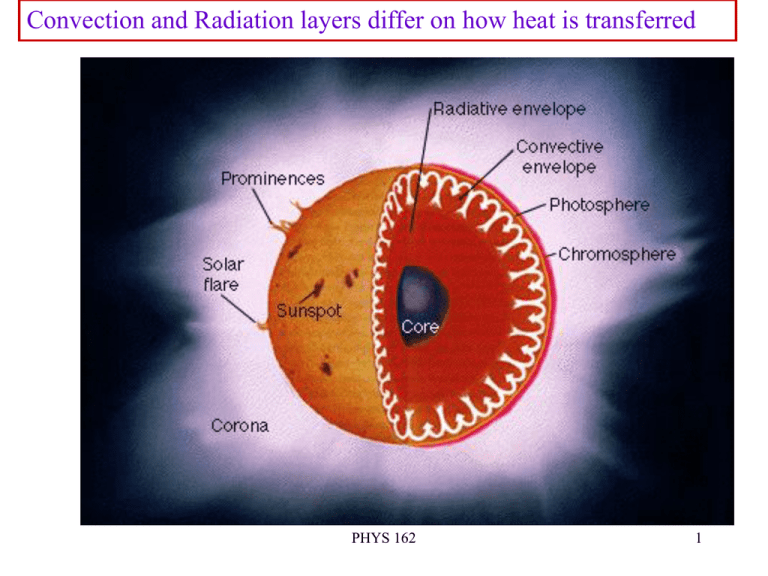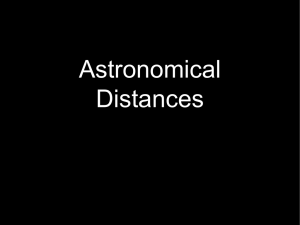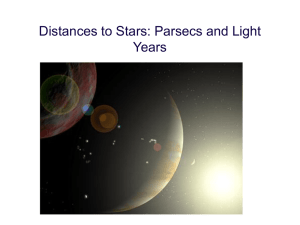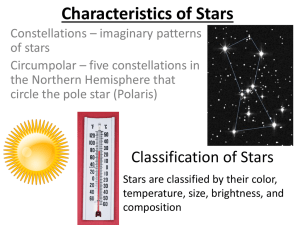Convection and Radiation layers differ on how heat is transferred 1
advertisement

Convection and Radiation layers differ on how heat is transferred PHYS 162 1 Outer Atmosphere • Can see during eclipses. Interactions of solar wind with Earth’s magnetic field and atmosphere causes Aurora Borealis PHYS 162 2 Aurora Borealis – Northern Lights seen at high latitudes as magnetic fields are lower in the atmosphere. rarely seen in DeKalb. Photos are from Alaska and Maine PHYS 162 3 Test 1 Guide for short answer questions • Motion of Sun, stars, and planets through sky vs season • Galileo’s astronomical observations • Kepler’s Laws of planetary motion • Newton’s Laws of motion (mostly F=ma) • how light is produced (accelerated charge) plus discrete vs. continuous • nuclear reactions in the Sun : p-p cycle • Layers in the Sun • 4 forces with examples PHYS 162 4 The Nature of Stars • Measure properties of Stars Distance Mass Absolute Brightness Surface Temperature Radius • Find that some are related Large Mass Large Brightness • Gives model of stellar formation and life cycle PHYS 162 5 Distances to Stars • Important as determines actual brightness but hard to measure as stars are so far away Closest Alpha Centauri 4.3 light years = 4 x 1013 km (1 AU = distance Earth to Sun = 8 light minutes) • Close stars use stellar parallax (heliocentric parallax or triangulation same meaning) • Can “easily” measure distance using parallax to a few 100 LY. Need telescope: first observed in 1838. Study close stars in detail. Other techniques (later) for distant stars PHYS 162 6 Distances to Stars - Parallax PHYS 162 7 Shifting Star Positions • • • • The orbit of the earth is used as the base. Near stars appear to move more than far stars distance = (base length)/angle define: 1 parsec = 1/(angle of 1 second of arc) = 3.3 LY site A December angle Sun site B June PHYS 162 8 Stellar Parallax • A photo of the stars will show the shift. July PHYS 162 9 Nearest Stars 61 Cygni first parallax in 1838 PHYS 162 10 Nearest Stars •The larger the angle (T.Par. = trigonometric parallax) the closer the star • many stars come in groups like the 2 stars in the Sirius “binary cluster” close together, within same “solar system” •Alpha Centauri and Procyon are close binary systems. Proxima Centauri is a red dwarf which probably orbits Alpha Centauri every 500,000 years PHYS 162 11 Parallax Data • In 1900 only 60 stars had parallax measurements • 1997-2000 a European satellite Hipparcos released parallax measurements for more than 2,300,000 stars up to 500 LY distance • 118,000 stars measured with .001 arc-second resolution and 0.2% error on light intensity • OLD(1990): 100 stars with distance known to 5%. “NEW” (2005): 7000 such stars • ESA Gaia satellite: 2013 0.00001 arc-second PHYS 162 12 Luminosity of Stars • Luminosity=Absolute Brightness=how much light/energy a star produces • Scale relative to Sun. So Lsirius = 23LS means Sirius radiates 23 times more energy than the Sun • Stars range from .0001xLS to 1,000,000xLS Another scale: “magnitude” often used. A log scale to the power of ~2.5. YOU DON’T NEED TO KNOW. The lower the Mag the brighter the object PHYS 162 13 Absolute vs Apparent Brightness Absolute Brightness/Luminosity means total energy output Apparent Brightness is what is seen by eye or in a telescope and so depends on distance (1/Distance2) PHYS 162 14







